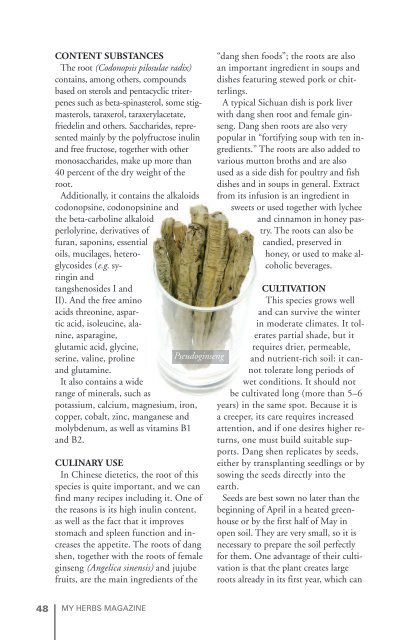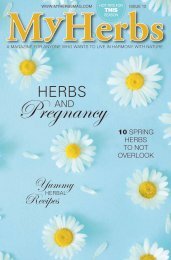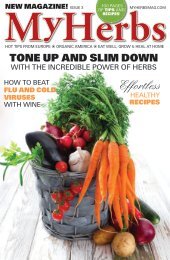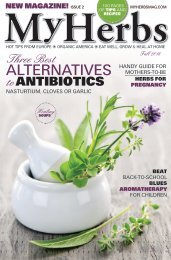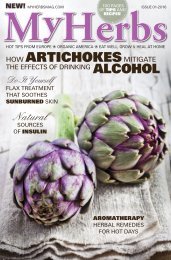My Herbs 1
Find out more on MYHERBS-STORE.COM. My Herbs is a special quarterly publication for anyone who is interested in alternative cooking, home grown herbs, and traditional or complementary medicine or healing methods, simply for everyone who wants to live in harmony with nature.
Find out more on MYHERBS-STORE.COM.
My Herbs is a special quarterly publication for anyone who is interested in alternative cooking, home grown herbs, and traditional or complementary medicine or healing methods, simply for everyone who wants to live in harmony with nature.
You also want an ePaper? Increase the reach of your titles
YUMPU automatically turns print PDFs into web optimized ePapers that Google loves.
CONTENT SUBSTANCES<br />
The root (Codonopsis pilosulae radix)<br />
contains, among others, compounds<br />
based on sterols and pentacyclic triterpenes<br />
such as beta-spinasterol, some stigmasterols,<br />
taraxerol, taraxerylacetate,<br />
friedelin and others. Saccharides, represented<br />
mainly by the polyfructose inulin<br />
and free fructose, together with other<br />
monosaccharides, make up more than<br />
40 percent of the dry weight of the<br />
root.<br />
Additionally, it contains the alkaloids<br />
codonopsine, codonopsinine and<br />
the beta-carboline alkaloid<br />
perlolyrine, derivatives of<br />
furan, saponins, essential<br />
oils, mucilages, heteroglycosides<br />
(e.g. syringin<br />
and<br />
tangshenosides I and<br />
II). And the free amino<br />
acids threonine, aspartic<br />
acid, isoleucine, alanine,<br />
asparagine,<br />
glutamic acid, glycine,<br />
serine, valine, proline<br />
and glutamine.<br />
It also contains a wide<br />
range of minerals, such as<br />
potassium, calcium, magnesium, iron,<br />
copper, cobalt, zinc, manganese and<br />
molybdenum, as well as vitamins B1<br />
and B2.<br />
CULINARY USE<br />
In Chinese dietetics, the root of this<br />
species is quite important, and we can<br />
find many recipes including it. One of<br />
the reasons is its high inulin content,<br />
as well as the fact that it improves<br />
stomach and spleen function and increases<br />
the appetite. The roots of dang<br />
shen, together with the roots of female<br />
ginseng (Angelica sinensis) and jujube<br />
fruits, are the main ingredients of the<br />
“dang shen foods”; the roots are also<br />
an important ingredient in soups and<br />
dishes featuring stewed pork or chitterlings.<br />
A typical Sichuan dish is pork liver<br />
with dang shen root and female ginseng.<br />
Dang shen roots are also very<br />
popular in “fortifying soup with ten ingredients.”<br />
The roots are also added to<br />
various mutton broths and are also<br />
used as a side dish for poultry and fish<br />
dishes and in soups in general. Extract<br />
from its infusion is an ingredient in<br />
sweets or used together with lychee<br />
and cinnamon in honey pastry.<br />
The roots can also be<br />
candied, preserved in<br />
honey, or used to make alcoholic<br />
beverages.<br />
CULTIVATION<br />
This species grows well<br />
and can survive the winter<br />
in moderate climates. It tolerates<br />
partial shade, but it<br />
requires drier, permeable,<br />
Pseudoginseng and nutrient-rich soil: it cannot<br />
tolerate long periods of<br />
wet conditions. It should not<br />
be cultivated long (more than 5–6<br />
years) in the same spot. Because it is<br />
a creeper, its care requires increased<br />
attention, and if one desires higher returns,<br />
one must build suitable supports.<br />
Dang shen replicates by seeds,<br />
either by transplanting seedlings or by<br />
sowing the seeds directly into the<br />
earth.<br />
Seeds are best sown no later than the<br />
beginning of April in a heated greenhouse<br />
or by the first half of May in<br />
open soil. They are very small, so it is<br />
necessary to prepare the soil perfectly<br />
for them. One advantage of their cultivation<br />
is that the plant creates large<br />
roots already in its first year, which can<br />
48 MY HERBS MAGAZINE


